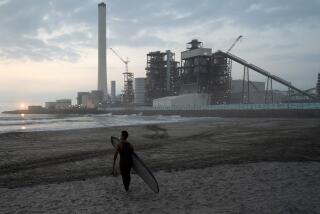Radiation exposure and the effects on human health
- Share via
As engineers have fought to avert a meltdown at the earthquake- and tsunami-crippled Fukushima No. 1 (Daiichi) power plant, nuclear authorities have reported that spikes of radiation have escaped from the facility at levels that can be dangerous to human health. Authorities have evacuated more than 170,000 people within 12 miles of the plant and have warned those within 20 miles to stay indoors and close off ventilation systems. They have also issued iodine tablets to those who have remained in the area and those at evacuation centers. At least 200 people have been exposed to radiation. Here’s a look at the potential radiation exposures and effects on human health.
Is all radiation harmful?
No. There are two types of radiation: non-ionizing and ionizing. Non-ionizing radiation includes infrared radiation, radio waves, cellphone radiation and the radiation we use to cook food in a microwave. Such radiation does not break chemical bonds. If it is very intense, it can heat up tissues; otherwise, it does not have significant effects. It is not believed to cause cancer.
Photos: Scenes of earthquake destruction
Ionizing radiation is much more dangerous because it does break chemical bonds and thus does cause cancer. Examples of this kind of radiation include X-rays, gamma rays and the alpha or beta particles emitted by radioactive elements as they decay.
What happens when someone is exposed to ionizing radiation?
That depends on how long you are exposed. The initial symptoms are identical to those suffered by a person undergoing radiation therapy for cancer. The first signs include nausea and fatigue, then vomiting. After that comes hair loss and diarrhea. For radiotherapy for tumors, the exposure generally stops after that point and the symptoms are controlled. But with heavier exposure, the next stage is generally destruction of the intestinal lining and worse diarrhea and dehydration, then central nervous system damage. After that comes loss of consciousness and, inevitably, death.
How does radiation released from nuclear plants compare with a nuclear bomb?
A nuclear explosion produces two types of radiation that has lethal effects. The blast itself produces X-rays and gamma rays that irradiate anyone near the site, usually with a lethal or near-lethal dose of radiation. Most of the 166,000 Japanese who died at Hiroshima in the first four months after the atomic bombing suffered from this type of radiation, which killed them directly or aggravated other injuries suffered in the blast.
It also produces clouds of radioactive ash that includes cesium-137, iodine-131, radioactive strontium and a host of other long-lived byproducts of the explosion — known collectively as fallout. This material can collect on skin and clothing, where it can emit radiation that pierces the skin. More important, it can accumulate in food, milk, water and other products that are ingested. It is not clear how many Hiroshima residents died of cancer from this source, but some estimates put it at more than 100,000.
Fukushima is not emitting gamma or X-irradiation. Most of the radioactivity is in the form of radiocesium and radioiodine, which are byproducts of the fission of uranium in the fuel rods.
What makes cesium-137 and iodine-131 dangerous?
Iodine-131 is absorbed preferentially in the thyroid gland, where it can cause tumors. It has a half-life of eight days and is most dangerous to children because it damages rapidly dividing cells. The problem can be substantially ameliorated by taking tablets of ordinary iodine, which bind to the thyroid and prevent the radioactive iodine from binding.
Cesium-137, which has a half-life of 30 years, is more serious. It is a salt that acts like potassium and goes everywhere in the body. It is absorbed into soft tissues, causing sarcomas. It contaminates food, water and milk and gets into the body when those things are ingested. Contamination with cesium-137 is one of the main reasons large areas of land had to be abandoned in the wake of the Chernobyl disaster in 1986.
How much exposure is enough to make someone sick?
The biological risk of exposure to radiation is measured in sieverts, or Sv. An exposure of 500,000 microsieverts, or µSv, can lead to nausea and fatigue within hours. A dose of 750,000 µSv causes hair loss within two or three weeks, and a dose of 1 million µSv will cause hemorrhage. Death usually occurs at a dose of 4 million µSv.
In terms of long-term effects, experts estimate that if 10,000 people were each exposed to 10,000 µSv of ionizing radiation in small doses over a lifetime, about five or six more people in the group would die of cancer than would be expected without the radiation exposure.
What were the health consequences of Chernobyl and Three Mile Island?
In the case of Chernobyl, United Nations reports have estimated that fewer than 50 people had died of causes directly related to radiation exposure. Most were rescue workers who had received high radiation doses; 28 died within the first few months. As many as 4,000 people are expected to eventually die of radiation-related causes. A 2005 report said about 4,000 thyroid cancers were directly related to radiation exposure, mostly in people who were children or adolescents at the time of the disaster and drank milk highly contaminated with radioactive iodine. At least nine died.
To track the health fallout of the 1979 Three Mile Island disaster, the Pennsylvania Department of Health kept a registry of more than 30,000 people who lived within five miles of the site at the time. Finding little evidence of significantly changed cancer rates, it discontinued the database in 1997.
So how much radiation have people in Japan been exposed to? How risky is it?
The levels of exposure are unclear. Radiation levels were reported to have jumped to about 400,000 µSv per hour inside the Fukushima plant after an explosion Tuesday, although the levels subsided rapidly. Sustained exposure to this level of radiation would be extremely hazardous. Levels outside the plant would have been substantially lower.
Civilians who have been exposed to radiation have been treated by simply getting their clothes washed and being given showers because the exposure has been so minimal.
Workers in the plant will receive the highest exposure, but they are outfitted with full protective gear, wear radiation badges and work for shifts of only an hour or two at a time. According to news reports, radiation levels in Tokyo have been 10 times normal, which is still very low.
Photos: Scenes of earthquake destruction
Times staff writers Thomas H. Maugh II and Amina Khan contributed to this report.






